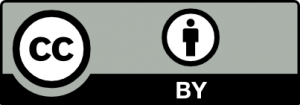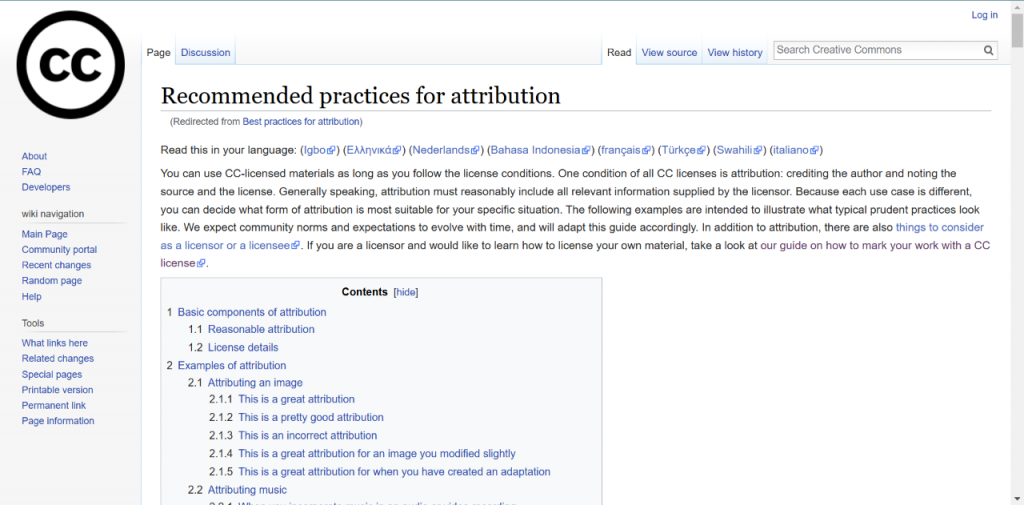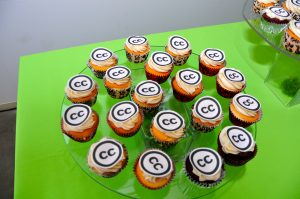4.1 Choosing and Applying a CC License
The act of applying a CC license is easy, but there are several important considerations to think through before you do.

CC BY License Icon. Trademark: Creative Commons.
Learning Outcomes
- Name the most important considerations before applying a CC license or CC0
- Apply a license using CC’s License Chooser and CC0 using CC’s Public Domain Dedication
- Evaluate which license to apply based on relevant factors
Big Question / Why It Matters
What should you consider before applying a CC license or CC0 to your work? There are several options from which to choose. There are also many things to think about before applying any CC license or CC0, including whether you have all the rights you need and, if not, how you must indicate that to the public.
Personal Reflection / Why it Matters To You
How would you go about choosing a particular CC license for your work? Do you know how to go about actually attaching a license to your work once you have chosen one? What if you change your mind about the license?
Acquiring Essential Knowledge
Before you decide that you want to apply a Creative Commons license or CC0 to your creative work, there are some important things to consider:
The licenses and CC0 are irrevocable.
Irrevocable means a legal agreement that cannot be canceled. That means once you apply a CC license to a work, the CC license applies to the work until the copyright on the work expires. This aspect of CC licensing is highly desirable from the perspective of reusers because they have confidence knowing the creator can’t arbitrarily pull back the rights granted them under the CC license.
Because the licenses are irrevocable, it is very important to carefully consider the options before deciding to use a CC license on a work.
You must own or control copyright in the work.
You should control copyright in the work to which you apply the license. For example, you don’t own or control any copyright in a work that is in the public domain, and you don’t own or control the copyright to an Enrique Iglesias song. Further, if you created the material in the scope of your employment, you may not be the holder of the rights and may need to get permission from your employer before applying a CC license. Before licensing, be mindful about whether you have copyright to the work to which you’re applying a CC license. Visit Unit 2.1 to review Copyright basics.
Which Creative Commons license should I use?
The six Creative Commons licenses provide a range of options for creators who want to share their work with the public while still retaining copyright. Creators can determine if they want the public to adapt their works, and if so, on what terms. The best way to decide which license is appropriate for you is to think about why you want to share and how you hope others will use your work.
For example, here are a few questions to consider:
- Do you want to require others to use your work only in unadapted form, or should they be able to adapt and innovate upon your work, translating it in other languages, or customizing it to better meet their needs?
- Are all reuses of your work acceptable, or do you need to restrict reuse in certain ways? For example, perhaps you only want to allow noncommercial uses of your work, or you want to ensure that adaptations are also shared with the same permissions as the original.
- Do you want to give away all of your rights in your work so that it can be used by anyone in the world for any purpose? Then think about using the public domain dedication tool, CC0, instead of one of the six CC licenses.
- Additional questions you might consider relate to the platform for reuse.
- Is it important to you that your images are able to be incorporated into Wikipedia? If so, then you should choose CC BY, BY-SA, or CC0, because Wikipedia does not allow images licensed under any of the NonCommercial or NoDerivatives licenses.
If you need some help deciding which license or tool might be best for you, CC offers the CC License Chooser. Take some time to experiment with the CC license chooser now. After you select the boxes that indicate your preferences, the chooser generates the appropriate license or tool based on your selections. Remember, the license chooser is not a registration page, it simply provides you with icons, standardized license language, and HTML code, which you can copy/paste to your work or website.
How do I apply a CC license to my work?
Once you’ve decided you want to use a CC license and know which license you want to use, applying it is simple. Technically, you just need to indicate which CC license you are applying to your work. However, we strongly recommend including a link (or writing out the CC license URL, if you are working offline) to the relevant CC license deed (e.g., https://creativecommons.org/licenses/by/4.0). You can do this in the copyright notice for your work, on the footer of your website, or any other place that makes sense in light of the particular format and medium of your work. The important thing is to make it clear what the CC license covers and locate the notice in a place that makes that clear to the public. See Marking your work with a CC license for more information. Note: we have additional recommendations for licensing statements in the Attribution section below.
Indicating which CC license you choose can be as simple as this notice from the footer of BC Open Textbooks.

Except where otherwise noted, content on this site is licensed under a Commons Attribution 4.0 International License
Popular platforms like YouTube, Medium and Flickr tend to have their own built-in CC license marking mechanisms. Worth noting: even these major platforms can have inaccuracies in their descriptions of CC licensing or limits to what can be licensed and how.
Here are some recommendations, when licensing your works on various platforms:
- Where possible, ensure your license has a working link the corresponding license on creativecommons.org.
- Spell out the URL of the license you choose for image-only formats, such as infographics.
- Add “bumpers” or short sections at the beginning or end for videos with your licensing statement. See CC’s video bumper guidelines and examples of CC bumpers.
- Read aloud licensing statements, including the URLs, in audio-only formats.
There are other important and popular platforms built for citizen science, like iNaturalist, where you can also select which license to use and search for images that are licensed under a CC license. Repositories for pre-prints like Zenodo also have built-in functions for choosing your license. Wikimedia Commons also allows you to choose your own license through their own built-in system, but it is only limited to the licenses that the Wikimedia projects accept.
As a general principle, whenever you are deciding how to apply your CC license, it is important to remember that CC licenses are designed with future users in mind. You want to make it easy for future users to understand what terms apply to their use of your work. So whenever you are applying a CC license, make your licensing statement easy to find and understand. Consider including additional information that a future user might need to provide good attribution to your work, such as the date of creation, your name, and a title for your work. More on attribution below.
For examples of CC licenses applied to different creations, from videos to websites to offline documents, view this CC Wiki on Marking Your Work with a CC license.
If you want to mark the work in a different way or need to use a different format like closing titles in a video, you can visit https://creativecommons.org/about/downloads/ and access downloadable versions of all of the CC icons.
Attribution
Giving and receiving credit for a creative work
An important aspect of CC licenses is attribution. While we recognize there are different recommended practices among different communities of practice, CC suggests following the “TASL” approach” for attribution practices (both for marking your work, and providing attribution to others):
- T = Title
- A = Author (tell reusers who to give credit to, and include a link where possible)
- S = Source (give reusers a link to the resource, often linked to the Title)
- L = License (both the actual license name and a link to the CC license deed)
If you give this information when sharing your work, others can easily discover, reuse, and give you credit for the work. Including TASL attribution is compatible with different citation styles; you are welcome to include TASL elements in different order, or include additional information with them to support citation formats. As a reminder: for more examples of how to mark your own work in different contexts, spend some time looking through CC’s extensive marking page. You can also see examples and recommended practices for attribution on our Recommended Practices for Attribution wiki.
Giving credit to the works of others
If you are using the work of others in your own work, you also have to give credit to those works in your own work.
When providing attribution, the recommended practice is to mark the work with full TASL information. When you don’t have some of the TASL information about a work, do the best you can and include as much detail as possible in the marking statement.
Note that starting with Version 4.0 the licenses no longer require a reuser to include the title as part of the attribution statement. However, if the title is provided, then CC encourages you to include it when attributing the author.
See below for an example of marking an image with TASL information. The following image is a good example of CC marking because TASL with all appropriate links is provided in the attribution statement.
Indicating if your work is based on someone else’s work – If your work is a modification or adaptation of another work, indicate this and provide attribution to the creator of the original work. You should also include a link to the work you modified and indicate what license applies to that work.
Example here:

This work, “90fied”, is a derivative of “Creative Commons 10th Birthday Celebration San Francisco” by tvol, used under CC BY. “90fied” is licensed under CC BY by [Your name here].
Marking work created by others that you are incorporating into your own work
Examples in our Recommended Practices for Attribution wiki:

In every case, the goals are the same: you want to make it easy for others to know who created what parts of the work. (1) Identify the terms under which any given work, or part of a work, can be used. (2) Provide information about works you used to create your new work or incorporated into your work.
Additional considerations for attributions
In some instances, it may be useful to include more attribution information than is strictly required by the license terms. We recommend including as much information as possible, to make things easier for potential users and re-users. For example, the CC License Chooser allows you to add the year of creation to your licensing statement, which could also be helpful information for re-users to include in their attributions: Example Title © 2024 by Joe Q. Author is licensed under CC BY-SA 4.0.
When using material that is in the public domain or has been released under CC0, for example, there is no legal requirement to provide attribution for this material, as there are no longer any copyright restrictions. However, attribution is often still a good idea for other reasons, such as acknowledging the work that others have done to make that work available, identifying sources of material to aid scholarship and research, and helping re-users understand where the materials have come from. We sometimes call this practice “CC0 + Attribution” to indicate that the work itself has been dedicated to the worldwide public domain, but the creator still requests attribution for their work. As an example, this is one of our primary recommended options in our Recommended Practices for Better Sharing of Climate Data. Attributing works, even when not legally required, is already an established norm across many areas of academic and scholarly research, science, and education.
Similarly, many cultural heritage institutions and other collection holders request to be attributed as the institutional provider of certain public domain materials. Institutions often play an important role in preserving, restoring, digitizing, and providing context and meaning for the cultural heritage that they steward and share. To acknowledge this additional labor, we often recommend that users provide an additional element in their TASL attributions – adding an “I” for “Institution” (sometimes referred to as TASIL). For example: “Ocean Coast by Maurice Denis, Public Domain Mark, Swedish National Museum,” which includes the Title (Ocean Coast), Author (Maurice Denis), Source (link), License (Public Domain Mark), and also the name of the Institution (Swedish National Museum). You can read more about these recommendations in our report, “Nudging Users to Reference Institutions When Using Public Domain Materials, Creative Commons Guidelines.”
Final remarks
When applying a CC license to a work: 1) Use the CC license chooser to determine which CC license best meets your needs. Apply the license code if possible, or copy / paste the text and links provided. 2) If you are using an online platform, use the built-in CC license tools to mark your work with a CC license. 3) Mark your work and give proper attribution to others’ works using the TASL approach.
There is no single answer for which CC license is the best. It is important to remember why you are sharing and what you hope others might do with your work, before making your CC license choice.
